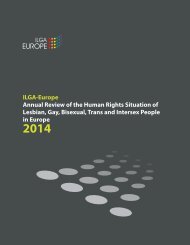Create successful ePaper yourself
Turn your PDF publications into a flip-book with our unique Google optimized e-Paper software.
„Pala kado chi vorbil khonyik. (…) Sakon<br />
daralas. (…) Maripo sas. Tala o maripo<br />
sakofelo sar pecisajvel. (…)<br />
O maripo aba nachilas, thaj vi kado<br />
bisterde le manusha.”<br />
Ande Lajoskomáromi – kanak ando gav, kana le rusura,<br />
kana le nyamcura sas – ando 1945 januari sako romen, kon<br />
ando gav beshnas, mudarde le lagericke shingale.<br />
Majanglal shtar mursha, pala kodo lenge nyamura, zhulyen<br />
thaj shavoren. Ando l995 o Jancsó Miklós,<br />
e Daróczi Ágnes thaj o Bársony János kerde filmo<br />
pala o Lajoskomáromesko mudaripo, le gaveske manusha,<br />
thaj jekh kaver manush, kasko dad mulas<br />
kothe phende so sas, sar sas.<br />
Kadale vorbi e Daróczi Ágnes iskirindas tele.<br />
Bognár Albert, gavesko sluga sas lo<br />
Me kodi zhanav ke ando lashipo samas le ro -<br />
menca. Kathe beshnas pasha amende. O Peller<br />
perdal beshlas po shanco, perdal po podo, thaj o<br />
Bajza Jancsi kathe tele ande Gropa. So le duje<br />
familijasa ando lashipo samas, von butyi kerde<br />
kathar e primevara zhi kaj e tomna.<br />
(…)<br />
Sar pecisajlas? Me kade zhanav kanak ingerde le<br />
manusha, le zhulyen thaj le shavoren opre shute<br />
pe jekh vurdon. Pasha le Gavesko kher sas jekh<br />
shusho kher kothe ingerde sakones. Pe ratyate le<br />
ketani aba hunavende lengi gropa. Kothe trade<br />
jekh vurdon thaj opre shute sakones…, le romnya<br />
shute opre le shavoren, pala kode le vurdonesa<br />
kothe ingerde len, tele shute len, tradenas<br />
len ande gropa pala kode tele pushkinde len.<br />
Kado na sas majbut sar jekh-duj minut. (…) Me<br />
somas atunchi le ga veske sluga. Kothe trubulas<br />
128<br />
„Nem beszél róla senki se. (…)<br />
Mindenki félt. (…) Hát háború volt.<br />
Sok minden történik a háború alatt. (…)<br />
Elmúlt a háború, aztán ez is el lett<br />
felejtve.”<br />
Lajoskomáromban – miközben a település hol az orosz,<br />
hol a német katonák kezére került – 1945 januárjának<br />
harmadik heté ben a falu összes roma lakosát meggyilkolták<br />
a tábori csen dôrök. Elôbb négy férfit, majd a többi<br />
hozzátartozót, asszo nyokat és gyermekeket.<br />
1995-ben Jancsó Miklós, Daróczi Ágnes és Bár sony János<br />
filmet készítettek a lajoskomáromi kivégzésrôl,<br />
a helybéliek és az egyik áldozat gyermekének<br />
visszaemlékezése alapján rekonstruálva a történetet.<br />
Az itt részleteiben közölt in terjúkat Daróczi Ágnes készítette.<br />
Bognár Albert volt községi szolga<br />
Hát annyit tudok, hogy jóban voltunk velük. Itt<br />
laktak a szomszédban. A Peller ott lakott az<br />
árkon, a hídon túl, a Bajza Jancsi meg itt lakott<br />
lent, a Gödörben. Mind a két családdal jóban<br />
voltunk, ezek nem kéregettek, ezek dolgoztak<br />
egész tavasztól ôszig, méghozzá keményen.<br />
(…)<br />
Hogy hogy történt? Hát én azt tudom elmesélni,<br />
vagy elmondani, hogy mikor az embereket<br />
elvitték, akkor a gyerekeket meg az asszo nyo kat<br />
kocsira rakták. Aztán ott a községháza mellett<br />
volt egy olyan üres óvodaépület, oda szállásolták<br />
be mindet. És estefelére, a katonák már<br />
megásták a sírjukat. Aztán odarendeltek egy<br />
kocsit, amire felpakolták az összeset…, mert hát<br />
az asszonyok rakták fel a gyerekeket, azután a<br />
kocsival odavitték ôket, ott aztán lerakták, hajtották<br />
befelé a gödörbe mind, utána meg gép-<br />
‘Nobody talks about it. (…) Everybody was<br />
afraid. (…) Well, there was war. Many<br />
things happen in wartime. (…) The war<br />
has ended, and this have been forgotten.’<br />
In Lajoskomárom – while the town was in Russian hands, then<br />
in German hands then in Russian hands, and so on –, in the<br />
third week of 1945 all the Roma inhabitants were killed by the<br />
gendarmes. First they killed four men, followed by the other<br />
relatives, the women and the children. In 1995 Miklós Jancsó,<br />
Ágnes Daróczi and János Bársony made a film about the executions<br />
in Lajoskomárom, then reconstructed the story based on<br />
the recollections of the locals and the child of one of the victims.<br />
The following extracts of the interviews were made by<br />
Ágnes Daróczi.<br />
Albert Bognár, ex-village servant<br />
I only know that we were on good terms with<br />
them. They lived next door. Peller lived on<br />
the drench, over the bridge, and Jancsi Bajza<br />
lived down here in the hole. We were on<br />
good terms with both families; they did not go<br />
begging, they worked from spring till autumn,<br />
they worked hard.<br />
(…)<br />
How did it happen? Well, I can only tell you<br />
that after the men had been taken away, they<br />
put the women and children in carriages. Then<br />
they took them to the parish hall, and put them<br />
in an empty nursery school. By evening, the<br />
soldiers had already dug their graves. Then they<br />
sent for a carriage and put all of them in it…,<br />
(because the women put on the children); so<br />
they were carried there by carriage, put down<br />
there, driven in the pit, and fired on by machine<br />
guns and the submachine-guns. It was over in a



